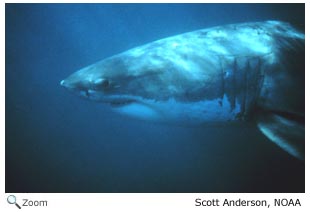 There are five species in this family of sharks. They range in size from 6-12 feet. They are found in temperate and tropical regions of all the world's oceans. There are five species in this family of sharks. They range in size from 6-12 feet. They are found in temperate and tropical regions of all the world's oceans.
Lamnids have five pairs of long gill slits; large, sharp teeth; torpedo shaped bodies; pointed snouts; two dorsal fins; and an anal fin. They are very fast swimmers and aggressive predators! Females give birth to live young. Sometimes baby sharks will eat their newly hatched siblings or their eggs while they are still in the female's womb.
Lamnids eat bony fish, sharks, rays, squid, and crustaceans. Some species are known to attack humans. Species include: the
great white shark, the
shortfin mako, the
longfin mako, the
salmon shark, and the
porbeagle shark.
World Status Key
 Least Concern Least Concern  Near Threatened Near Threatened  Vulnerable Vulnerable  Endangered Endangered  Critically Endangered Critically Endangered  Extinct Wild Extinct Wild  Extinct Extinct
Status taken from ICUN Redlist. If no status is listed, there is not enough data to establish status, or there is no status data for the species.
US Status Key
 Threatened in US Threatened in US  Threatened in NH Threatened in NH  Endangered in US Endangered in US  Endangered in NH Endangered in NH  Introduced Introduced
Status taken from US Fish and Wildlife and NH Fish and Game
Additional Information Resource Key
 Profile Profile  Photos Photos  Video Video  Audio Audio
Great White Shark - Carcharodon carcharias              
The great white shark has an excellent sense of smell.
Source: Arkive Intended Audience: General Reading Level: Middle School
Great White Shark - Carcharodon carcharias             
Great white sharks are the largest predatory fish on Earth.
Source: National Geographic Intended Audience: General Reading Level: Middle School
Great White Shark - Carcharodon carcharias             
The great white shark has 3,000 teeth at any one time.
Source: Enchanted Learning Intended Audience: Students Reading Level: Elementary School
Great White Shark - Carcharodon carcharias              
The great white shark can reach 22 feet in length and weigh more than two tons.
Source: Monterey Bay Aquarium Intended Audience: Students Reading Level: Middle School
Longfin Mako - Isurus paucus            
The longfin mako has a slender, torpedo-shaped body.
Source: Arkive Intended Audience: General Reading Level: Middle School
Longfin Mako - Isurus paucus           
The longfin mako is found in tropical and warm waters worldwide.
Source: Florida Museum Natural History Intended Audience: Students Reading Level: High School
Porbeagle - Lamna nasus             
The porbeagle shark is usually found in waters over continental shelves.
Source: Arkive Intended Audience: General Reading Level: Middle School
Porbeagle - Lamna nasus            
In the northern hemisphere, the porbeagle shark is only found in the Atlantic Ocean.
Source: Florida Museum Natural History Intended Audience: Students Reading Level: High School
Salmon Shark - Lamna ditropis      
The salmon shark is sometimes mistaken for the white shark.
Source: Arkive Intended Audience: General Reading Level: Middle School
Salmon Shark - Lamna ditropis     
The salmon shark is only found in the coastal and oceanic waters of the North Pacific.
Source: Florida Museum Natural History Intended Audience: Students Reading Level: High School
Shortfin Mako - Isurus oxyrinchus              
The shortfin mako is thought to be the fastest swimmer of all the sharks.
Source: Arkive Intended Audience: General Reading Level: Middle School
Shortfin Mako - Isurus oxyrinchus             
The shortfin mako is found in tropical and temperate waters throughout the world's oceans.
Source: Florida Museum Natural History Intended Audience: Students Reading Level: High School |

